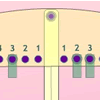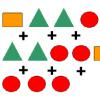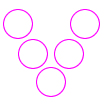Or search by topic
Number and algebra
Geometry and measure
Probability and statistics
Working mathematically
Advanced mathematics
For younger learners
Published 2014 Revised 2015
Making Algebra Rich
In her article 'What's X Got to Do with It?' Anne Watson describes how, even though algebra is only mentioned formally in the year 6 programme of study in the new National Curriculum, the roots of algebraic thinking can be traced back throughout the primary years. This feature brings together rich activities that support early algebraic thinking, and one or two that support
the more formal algebra in year 6.
Balancing and the equals sign
 Anne describes the importance of ensuring that = does not signify a calculating instruction ('makes') but does mean 'equivalent to'. The idea of both sides of an equation being worth the same is a fundamental concept but many children don't realise that 4 + 5 = 9 can be written:
Anne describes the importance of ensuring that = does not signify a calculating instruction ('makes') but does mean 'equivalent to'. The idea of both sides of an equation being worth the same is a fundamental concept but many children don't realise that 4 + 5 = 9 can be written:
4 + 5 = 6 + 3, 4 + 5 = 7 + 2, 4 + 5 = 11 - 2 or even 4 + 5 = 3 x 3.
This idea of equivalence can be illustrated beautifully using a balance. The NRICH team is developing a non-Flash interactive balance to replace a previous version, watch this space!
Using symbols then letters
 The idea of equivalence is important in missing number problems. They are initially used where we want children to recall and use a number fact, for example 6 + ? = 10, in which if you know your number bonds to 10, the answer is obvious. Later we want them to use a symbol as a place holder for an unknown quantity where
the answer is not immediately obvious and we have to do some work to find a solution. Heads and Feet (KS1) and Plenty of Pens (KS2) are both types of missing number problems
The idea of equivalence is important in missing number problems. They are initially used where we want children to recall and use a number fact, for example 6 + ? = 10, in which if you know your number bonds to 10, the answer is obvious. Later we want them to use a symbol as a place holder for an unknown quantity where
the answer is not immediately obvious and we have to do some work to find a solution. Heads and Feet (KS1) and Plenty of Pens (KS2) are both types of missing number problems  which encourage children to use personal representations (using objects
or perhaps drawing) and then, if appropriate, to move into using symbols. And if you'd like your pupils to become more confident in using symbols, you could offer them Super Shapes or Shape Times Shape, both of which are problems requiring chains of reasoning and offer excellent opportunities for children to communicate their thinking.
which encourage children to use personal representations (using objects
or perhaps drawing) and then, if appropriate, to move into using symbols. And if you'd like your pupils to become more confident in using symbols, you could offer them Super Shapes or Shape Times Shape, both of which are problems requiring chains of reasoning and offer excellent opportunities for children to communicate their thinking.
Generalising from a number of examples and stating a rule
 Maths is shot through with patterns. The algebraic idea of finding a rule implies first noticing a pattern and then generalising it. In the early stages the generalisation will be a statement in words, later this may be refomulated into symbolic representation. Ip Dip (KS1) is a well known
elimination game (similar to one potato, two potato) for younger pupils. Can they predict what will happen if they start the rhyme in different places and what patterns do they notice? How can they record this - perhaps in words or maybe in a picture? In Sticky Triangles (KS2) pupils are asked to make geometric patterns with sticks and predict how many they would need to
continue the pattern. This idea of linking geometry with number is one that becomes more important as pupils' understanding progresses, as is finding elegant ways of recording which support pattern spotting.
Maths is shot through with patterns. The algebraic idea of finding a rule implies first noticing a pattern and then generalising it. In the early stages the generalisation will be a statement in words, later this may be refomulated into symbolic representation. Ip Dip (KS1) is a well known
elimination game (similar to one potato, two potato) for younger pupils. Can they predict what will happen if they start the rhyme in different places and what patterns do they notice? How can they record this - perhaps in words or maybe in a picture? In Sticky Triangles (KS2) pupils are asked to make geometric patterns with sticks and predict how many they would need to
continue the pattern. This idea of linking geometry with number is one that becomes more important as pupils' understanding progresses, as is finding elegant ways of recording which support pattern spotting.
 On NRICH there are many more longer investigations which require children to conjecture, convince and prove, and using algebraic notation can often be helpful in the latter. For KS2 children you may want to revisit Magic Vs (an old NRICH favourite) or Up and Down Staircases.
On NRICH there are many more longer investigations which require children to conjecture, convince and prove, and using algebraic notation can often be helpful in the latter. For KS2 children you may want to revisit Magic Vs (an old NRICH favourite) or Up and Down Staircases.
For even more algebra possibilities have a look at the Patterns and Sequences collections for KS1 or KS2.

